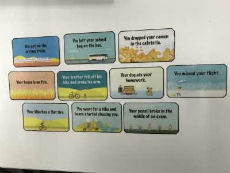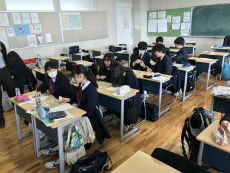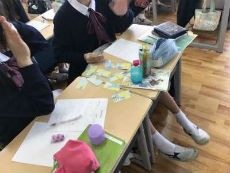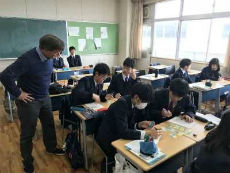
学園ブログ

- ホーム
- 世界へはばたく
世界へはばたく

2018年02月05日
中3の英会話授業より

誰かに助けを求めること、抱えている問題を上手く説明すること、問題に関わる質問をしたり答えたりすること、また、問題に対する解決を提案すること。これらは全て、私たちが生徒に身につけて欲しい能力です。
これらの能力は、学校でのコミュニケーションクラスでより発展的なディスカッションをするためだけでなく、生徒たちが将来、現実に問題と直面し、英語を使わなければならない時に非常に役に立つと考えています。
中3の英会話の授業は、週1回50分を担当者ごとに2分割し、25分×2回(2週で50分の内容)で実施しています。
授業はたいてい2週続きで行いますが、1回目の最初の25分で、教師がKeynoteを使って簡単なプレゼンテーションをします。それによって、問題解決のためアクティビティーでは何をするのか、また、タスクをこなすための効果的なやり方等を簡単に説明します。
このアクティビティーでは、生徒は2人1組になって取り組みます。どのペアも、さまざまな問題が書かれた10枚セットのカードを使います。例えば、「あなたの家が火事です。」、「あなたは飛行機に乗り遅れました。」、「あなたの犬が宿題を食べてしまいました。」などです。まず、どちらが先に始めるかを決め(先にする方をAとします。)、カードをひき、それを読んで、パートナー(Bとします。)に問題に関わって助けを求めます。BはAに対して、問題について5つの質問をします。これをすることで、Bが問題についてより深く理解し、よりよい解決の提案につながるので、非常に大切なプロセスです。5つの質問のやり取りが終わると、Bは解決法を提案し、Aは助けてくれたことに対してお礼を言います。そして、AとBで役割を交代し,今度はBがカードをひいて、助けを求めます。このやり取りが授業の終わりまで続きます。


2回目の授業では、生徒は解決したい問題を選び、教室内でそれを演じるために必要な会話のやりとりを書き出します。授業の終わりの10分で3~4ペアが問題解決の会話のやりとりを発表し、他の生徒や教師から建設的なフィードバックをもらいます。
2回の授業とも、生徒は提示された問題に対して、よりよい答えを見つけようと必死になって、主体的に取り組みます。我々教師は、生徒がより創造的な解決法を見つけられるよう手助けしますが、生徒が楽しんでチャレンジしているのがよく分かります。


これから、生徒たちの高校進学後も、このように会話のやり取りと問題解決能力を統合した活動を授業に取り入れていきたいと考えています。
Learning how to ask someone for help, describe a problem, ask and answer questions related to the problem and propose solutions to the problem are all skills we want our students to have.
These skills will be crucial to the more advanced discussions they will be having in their high school communication classes and, more importantly, useful tools for them when they need to use English to deal with real-world problems in the future.
In the first 25-minute lesson in a two-lesson series, students were shown a brief Keynote presentation that explained the rules of the problem-solving activity they would be doing, and gave examples of effective ways to complete the tasks.
In this activity, students worked in pairs. Each pair had a set of 10 printed cards with various problems printed on them. Examples include “Your house is on fire,” “You missed your flight,” and “Your dog ate your homework.” They decided who would go first (Student A) and that player drew a card, read it and then proceeded to ask their partner (Student B) for help with their problem. Student B, in turn, asked Student A five questions about the problem. This is important, as it allowed Student B to get a better understanding of the problem and propose better solutions. After asking and receiving answers to the five questions, Student B proposed a solution and Student A thanked Student B for his/her help. On the next turn, they changed roles and Student B drew a card and asked for help. This continued until the class was finished.
On the second day of this lesson, students chose a problem they wanted to solve and wrote out a dialog they could perform for the class. In the last 10 minutes of the second class, 3 or 4 pairs performed their problem-solving dialog for their classmates and received constructive feedback from the students and teachers.
On both days of this lesson, students remained engaged and active in trying to find good answers to the problems they were presented. We encouraged students to come up with creative solutions and it was clear that they were really enjoying the challenge.
We intend to integrate question-asking and problem-solving skills in lessons students will have once they have entered high school.
(中高校ALT マット・キャスティ)
